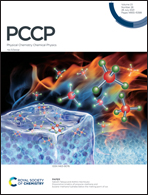Phonon, plasmon and electronic properties of surfaces and interfaces of periodic W/Si and Si/W multilayers†
Abstract
The phonon and plasmon excitations and electronic properties of interfaces of periodic W/Si and Si/W multilayer structures were investigated. The Boson band originated from quasilocal surface acoustic phonons for ultrathin Si layers, excited by Raman scattering. In confined Si layers, a small fraction of crystalline Si nanoclusters were embedded within a large volume fraction of amorphous Si (a-Si) nanoclusters. The size of the a-Si nanoclusters was smaller for the thinner Si layer in the periodic layers. The plasmon energy in the Si layer was blueshifted with a decrease in the thickness of this layer. This was explained by the size-dependent quantization of plasmon shift. The valence band spectra comprised a substantial fine structure, which is associated with the interaction of valence orbitals of the W and Si atoms at the interface boundaries. For thinner Si layers, the binding interaction of W5d and Si3p states leads to the splitting of the density of states near the Fermi level in the energy range of 1.5–5 eV. However, the energy splitting with two maxima was observed at 0.7 and 2.4 eV for thicker layers. Thus, the results of X-ray photoelectron spectroscopy have indicated that the interface of W/Si multilayers consists of metal-enriched tungsten silicide. Both the atomic structure and the elemental composition of the silicide were modified with a change in the thickness of the Si layers. This novel investigation could be essential for designing nanomirrors with higher reflectivity.

- This article is part of the themed collection: 2021 PCCP HOT Articles


 Please wait while we load your content...
Please wait while we load your content...